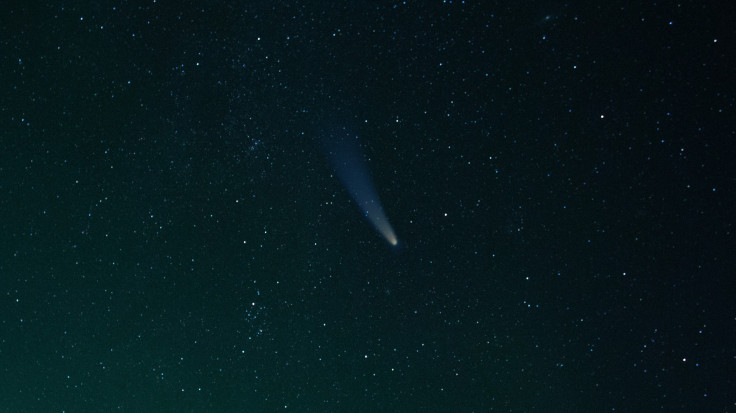
The interstellar object 3I/ATLAS has become the subject of online speculation, with a fabricated image suggesting it is an alien artefact. A single, stylised frame showing a sharp, bullet-shaped object is now attracting significant interest and discussion across X and Instagram, prompting questions about its authenticity.
In the viral image, the interstellar visitor appears as a gleaming, sculpted body with glowing structures on-screen readouts. In reality, official NASA views of 3I/ATLAS remain low‑resolution shots of a faint comet with a coma and tail, and the gap between artistic renderings and scientific reality has allowed misinformation to spread.
How The Viral 3I/ATLAS 'Leak' Took Over Social Media
The latest image spread from a popular X thread by the account UFO mania, which shared the frame with the prompt:
'Another supposedly 3I/ATLAS leaked Photo... real or fake?'
From there, it was shared on Instagram and other platforms, sparking claims that agencies are hiding high‑definition shots of the object.
The post's open question invites a verdict, and users have rushed in with their own forensic analyses.
The frame uses false colour and overlaid boxes that resemble generic software readouts, yet lists no instrument, observatory or time stamp.
Similar graphics have circulated for weeks under a 'NASA leak' tagline, always without provenance and always just polished enough to feel cinematic.
Reactions in the same thread capture the split. One user argued that the labels and typography resemble AI composites rather than mission metadata, writing:
'Fake as f***. Look at the AI text.'
Others take the image at face value and fold it into a narrative of hidden data and secret surveillance of 3I/ATLAS.
What Telescopes Actually See Of 3I/ATLAS
Astronomers counter that current telescopes simply cannot resolve the solid core of 3I/ATLAS at these distances. The comet's closest approach to Earth remains distant, and its apparent size in the sky is tiny.
Michael McNeil noted this directly in the same thread, stating that,
"neither Nasa's nor anybody else's images of 3I/ATLAS itself—its 3-km (2-mile) nucleus—are worth a damn,"
He added that the object's angular size during the Mars pass was "~0.02 arc-seconds," a figure far too small to yield a detailed shape, even for Hubble.
A check against official galleries supports that view. Official NASA public 3I/ATLAS pages show Hubble's July image and later updates, all documenting a small coma and tail with full instrument labels, exposure times and captions.
No release matches the viral, sylised image, which is exactly what astronomers expect for an object whose core remains unresolved.
That distance explains why real pictures show a faint glow and faint tails rather than a sculpted metallic body. Observers are looking at a tiny, fast object wapped in dust and gas, not a clearly defined spacecraft model.
The Japanese have leaked actual footage of 3i Atlas.... That's definitely a large vessel! pic.twitter.com/EP877y900s
— Truth Doctor (@RealTruthDoctor) October 22, 2025
Experts Say 3I/ATLAS Looks Like A Normal Comet
Independent expert commentary aligns with the official imagery. A The Guardian report dated 11 September 2025, NASA small bodies lead scientist Tom Statler said, 'It looks like a comet. It does comet things. It very, very strongly resembles, in just about every way, the comets that we know.'
The same article reports NASA's rejection of claims that 3I/ATLAS is of alien origin, stressing that its behaviour fits comfortably within known comet physics.
The sharpest official frame to date shows a teardrop‑like coma, with background stars stretched into streaks because the telescope tracks the comet rather than the star field. As per the NASA Science release dated 7 August 2025, team member David Jewitt stated,
"No one knows where the comet came from. It's like glimpsing a rifle bullet for a thousandth of a second."
Jewitt's analogy underlines how little structure any telescope can hope to see. The object travels through the inner Solar System at high speed, presenting only a tiny, blurred target, even to space‑based observatories.
Why Basic Optics Say The 3I/ATLAS 'Leaked Photo' Is Almost Certainly Fake
Hubble's own team have been explicit about the limits. As the NASA Science report dated 7 August 2025 noted of the images,
"Though the Hubble images put tighter constraints on the size of the nucleus compared to previous ground-based estimates, the solid heart of the comet presently cannot be directly seen, even by Hubble."
If the nucleus is still unresolved for Hubble, then any crisp, multi‑pixel, 'ship‑like' body in a casual social post should be treated as art, not data.
A side‑by‑side comparison with official releases also highlights missing basics. Real NASA frames carry clear labels for telescope, instrument, filter and scale; the viral picture has none of that. Its typography and interface hints look more like entertainment graphics than scientific readouts.
Mainstream NASA voices also emphasise that 3I/ATLAS poses no threat to Earth. As per the NASA Science report dated November 2025, the page noted,
"There is no danger to Earth from this comet, which will come no closer than 170 million miles (270 million kilometres), or 1.8 astronomical units, to our planet."
The real story, then, is less about a hidden alien probe and more about how a single striking image can outrun the quieter, fuzzier truth of what our best instruments can actually see.







